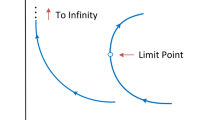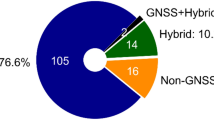Abstract
Orbit propagation algorithms for satellite relative motion relying on Runge–Kutta integrators are non-symplectic—a situation that leads to incorrect global behavior and degraded accuracy. Thus, attempts have been made to apply symplectic methods to integrate satellite relative motion. However, so far all these symplectic propagation schemes have not taken into account the effect of atmospheric drag. In this paper, drag-generalized symplectic and variational algorithms for satellite relative orbit propagation are developed in different reference frames, and numerical simulations with and without the effect of atmospheric drag are presented. It is also shown that high-order versions of the newly-developed variational and symplectic propagators are more accurate and are significantly faster than Runge–Kutta-based integrators, even in the presence of atmospheric drag.











Similar content being viewed by others
Notes
Throughout this study, we exclude the effect of the atmospheric velocity on the overall drag force.
References
Alfriend, K., Vadali, S.R., Gurfil, P., How, J., Breger, L.: Spacecraft Formation Flying: Dynamics, Control, and Navigation. Butterworth-Heinemann, Oxford (2009)
Blanes, S., Casas, F.: A Concise Introduction to Geometric Numerical Integration, 1st edn. CRC Press, Baco Raton (2016)
Blanes, S., Casas, F., Farres, A., Laskar, J., Makazaga, J., Murua, A.: New families of symplectic splitting methods for numerical integration in dynamical astronomy. Appl. Numer. Math. 68, 58–72 (2013). https://doi.org/10.1016/j.apnum.2013.01.003
Engeln-Mulges, G.: Numerical Algorithms with C, 1st edn. Springer, New York (1996)
Fahnestock, E.G., Lee, T., Leok, M., McClamroch, N.H., Scheeres, D.J.: (2006) Polyhedral potential and variational integrator computation of the full two body problem. In: AIAA/AAS Astrodynamics Specialist Conference. https://doi.org/10.2514/6.2006-6289, http://arxiv.org/abs/math/0608695
Farres, A., Laskar, J., Blanes, S., Casas, F., Makazaga, J., Murua, A.: High precision symplectic integrators for the solar system. Celest. Mech. Dyn. Astron. 116(2), 141–174 (2013). https://doi.org/10.1007/s10569-013-9479-6
Feng, K., Qin, M.: Symplectic Geometric Algorithms for Hamiltonian Systems, 1st edn. (2010). https://doi.org/10.1007/978-3-642-01777-3, https://books.google.com/books?id=L8wGeoxvuDsC&pgis=1
Hairer, E., Nørsett, S.P., Wanner, G.: Solving Ordinary Differential Equations I: Nonstiff Problems, 2nd edn. Springer, Berlin (1993)
Hairer, E., Lubich, C., Wanner, G.: Geometric numerical integration illustrated by the Stormer–Verlet method. Acta Numer. 12(2003), 399–450 (2003). https://doi.org/10.1017/S0962492902000144, http://www.journals.cambridge.org/abstract_S0962492902000144
Hairer, E., Lubich, C., Wanner, G.: Geometric Numerical Integration Algorithms for Ordinary Differential Equations, 2nd edn. Springer, New York (2006)
Imre, E., Palmer, P.L.: High-precision, symplectic numerical, relative orbit propagation. J. Guid. Control Dyn. 30(4), 965–973 (2007). https://doi.org/10.2514/1.26846
Kane, C., Marsden, J.E., Ortiz, M., West, M.: Variational integrators and the Newmark algorithm for conservative and dissipative mechanical systems. Int. J. Numer. Methods Eng. 49(10), 1295–1325 (2000). https://doi.org/10.1002/1097-0207(20001210)49:10<1295::AID-NME993>3.0.CO;2-W
Kechichian, J.A.: Motion in general elliptic orbit with respect to a dragging and presessing coordinate frame. J. Astronaut. Sci. 46(1), 25–45 (1998)
Kharevych, L., Yang, W., Tong, Y., Kanso, E., Marsden, J.E., Schröder, P., et al.: Geometric, variational integrators for computer animation. In: Eurographics/ACM SIGGRAPH Symposium on Computer Animation, vol. 24, pp. 43–51. (2006). https://doi.org/10.1145/1073204.1073300, http://portal.acm.org/citation.cfm?id=1218064.1218071
Lara, M., Gurfil, P.: Integrable approximation of J2-perturbed relative orbits. Celest. Mech. Dyn. Astronaut. 114(3), 229–254 (2012). https://doi.org/10.1007/s10569-012-9437-8
Lee, D., Springmann, J., Spangelo, S., Cutler, J.: Satellite dynamics simulator development using lie group variational integrator. In: AIAA Modeling and Simulation Technologies Conference, August, pp. 1–20. (2011). https://doi.org/10.2514/6.2011-6430
Lee, T., Leok, M., McClamroch, N.H.: Lie group variational integrators for the full body problem in orbital mechanics. Celest. Mech. Dyn. Astron. 98(2), 121–144 (2007). https://doi.org/10.1007/s10569-007-9073-x
Lee, T.L.T., McClamroch, N., Leok, M.: A lie group variational integrator for the attitude dynamics of a rigid body with applications to the 3D pendulum. In: Proceedings of 2005 IEEE Conference on Control Applications, 2005 CCA, pp. 962–967. (2005). https://doi.org/10.1109/CCA.2005.1507254
Leimkuhler, B., Reich, S.: Simulating Hamiltonian Dynamics. Cambridge Monographs on Applied and Computational Mathematics. Cambridge University Press, Cambridge (2005). https://doi.org/10.1017/CBO9780511614118
Lew, A., Marsden, J.E., Ortiz, M., West, M.: Variational time integrators. Int. J. Numer. Method Eng. 60(1), 153–212 (2004). https://doi.org/10.1002/nme.958
Marsden, J.E., West, M.: Discrete mechanics and variational integrators. Acta Numer. (January 2003):1–158. (2001). https://doi.org/10.1017/S096249290100006X, http://www3.nd.edu/~izaguirr/papers/acta_numerica.pdf
Modin, K., Söderlind, G.: Geometric integration of Hamiltonian systems perturbed by Rayleigh damping. BIT Numer. Math. 51(4), 977–1007 (2011). https://doi.org/10.1007/s10543-011-0345-1
Nordkvist, N., Sanyal, A.K.: A lie group variational integrator for rigid body motion in SE(3) with applications to underwater vehicle dynamics. Proc. IEEE Conf. Decis. Control 3, 5414–5419 (2010). https://doi.org/10.1109/CDC.2010.5717622
Schaub, H., Junkins, J.L.: Analytical Mechanics of Space Systems, 2nd edn. American Institute of Aeronautics and Astronautics Inc, Reston (2009)
Simo, J.C., Tarnow, N., Wong, K.K.: Exact energy-momentum conserving algorithms and symplectic schemes for nonlinear dynamics. Comput. Methods Appl. Mech. Eng. 100(1), 63–116 (1992). https://doi.org/10.1016/0045-7825(92)90115-Z
Suzuki, M.: Fractal decomposition of exponential operators with applications to many-body theories and Monte Carlo simulations. Phys. Lett. A 146(6), 319–323 (1990)
Tsuda, Y., Scheeres, D.J.: Computation and applications of an orbital dynamics symplectic state transition matrix. Adv. Astronaut. Sci. 134(4), 899–918 (2009). https://doi.org/10.2514/1.42358
Yoshida, H.: Construction of higher order symplectic integrators. Phys. Lett. A 150(5–7), 262–268 (1990). https://doi.org/10.1016/0375-9601(90)90092-3
Author information
Authors and Affiliations
Corresponding author
Additional information
This work was supported by the European Commission Horizon 2020 Program in the framework of the Sensor Swarm Sensor Network Project under Grant Agreement 687351.
Appendices
Appendix A: transformation from earth-centered inertial to LVLH
The relative position between two satellites in elliptic orbits can be expressed in the LVLH reference frame using the relations (Alfriend et al. 2009)
where \(\varvec{h}_{L} = \varvec{r}_{L} \times \varvec{v}_{L}\). Next, the relative velocity expressed also in the LVLH reference frame is obtained by differentiating the previous equations:
where \(\dot{\varvec{h}}_{L} = \varvec{r}_{L} \times \dot{\varvec{v}}_{L}\).
Appendix B: elements of the Jacobian matrix
The exact calculation of the elements of the Jacobian matrix are used to improve the speed of the Newton–Raphson method in the semi-implicit symplectic integrator presented in Sect. 3.2.1. First, the system of equations of interest is re-arranged in the form \(f(x) = 0\) and then the expression is differentiated with respect to the unknown elements. For the half-indexed momenta, Eqs. (41) and (42) are re-arranged as
and then each of these equations is differentiated with respect to the unknown elements \(R_{1/2}\) and \(\varTheta _{1/2}\),
Then, for the new positions, Eqs. (44)–(46) are re-arranged as
After differentiating each of these equations with respect to the unknown elements \(r_{+}\), \(\theta _{+}\) and \(\nu _{+}\), we obtain the expressions:
Rights and permissions
About this article
Cite this article
Palacios, L., Gurfil, P. Variational and symplectic integrators for satellite relative orbit propagation including drag. Celest Mech Dyn Astr 130, 31 (2018). https://doi.org/10.1007/s10569-018-9826-8
Received:
Revised:
Accepted:
Published:
DOI: https://doi.org/10.1007/s10569-018-9826-8




